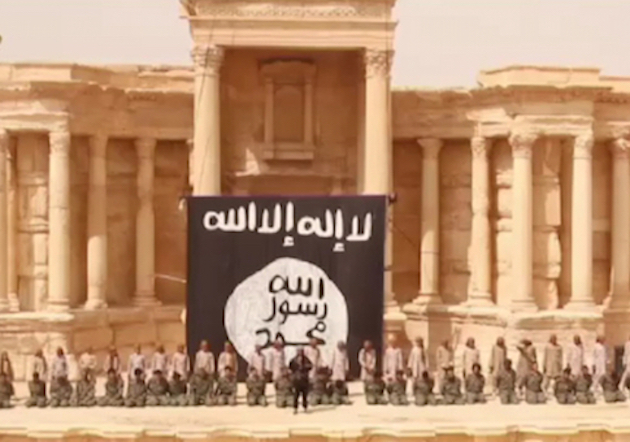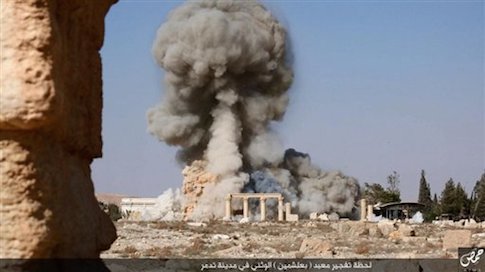A little over two weeks ago, agents of the Islamic State escorted Khaled al-Asaad, the retired director of Palmyra’s complex of antiquities, to the square in front of the city’s principal museum and beheaded the 82-year-old before an audience of militants. They then strapped his headless body to a light-pole upside down, attaching to it a sign that listed his various crimes. Several of these had a medieval but recently all-too-familiar ring to them: apostasy, of course, as well as representing the Syrian government at international conferences of infidels (archaeological symposia, it seems) and superintending the "idols" of the city.
Shortly thereafter they got down to the serious work of leveling the sanctuaries of said idols. Having been in control of the city since May, the continued existence of the Temples of Baal and of Baalshamin had perhaps become an embarrassment to ISIS, but other matters had taken priority: the elimination of a pair of shrines held dear by Shia Muslims; the leveling of an infamous Assad (no direct relation to the archeologist, for what it’s worth) regime prison, which had been the scene of a massacre of Muslim Brotherhood prisoners in 1980; a general orgy of violence targeting government troops and loyalists, including a mass execution of regime soldiers staged in the Roman amphitheater. There, teenage boys had lined up and shot the prisoners on stage before an enormous Islamic State banner in a scene that could have been staged by Leni Riefenstahl, had she decided to drop the pretenses and just start making snuff films.

The Temple of Baalshamin, built in stages around 2000 years ago, went up in a tremendous explosion on 23 August, followed by the Temple of Baal’s destruction on the 30th. The latter, it is interesting to note, had been at some point in its history outfitted with a mihrab—the niche oriented toward Mecca that shows the proper direction for Muslim prayer—indicating that earlier generations of Muslims in the oasis city had been willing to let bygones be bygones and satisfy themselves with using the temple for their own purposes. There is also evidence that, during an even earlier age of Byzantine dominance, the structure had been used as a church.
Then again, none of these earlier worshippers had access to the kind of high explosives available to the Islamic State. Modern weaponry, combined with the new Caliphate’s highly distilled fanaticism, can really up one’s iconoclastic game.
The United Nations’ cultural agency swiftly condemned these acts of destruction as "war crimes," an accusation at which the perpetrators must still be laughing. ("Abdullah, UNESCO says we’ve committed war crimes! We may have gone too far on this one...") Earlier in the summer, before the destruction of the two temples but after it had become clear that Palmyra’s antiquities were in for some tough times, the Freer-Sackler Gallery in Washington, D.C., brought out of storage a Roman-era funerary relief that originated in Palmyra, before being purchased in 1908 by the gallery’s founder. It is currently on display "indefinitely," according to the museum, along with a television that cycles through images of prints and photographs of Palmyra from the museum’s archives.
Visiting the display, tucked in the corner of one of the Sackler’s underground galleries, I was caught between the wanting to roll my eyes at the tokenism of the gesture, and the more generous thought that at least these curators are doing what they can. After all, the museum’s little pop-up is no more ineffective against the ongoing existence of the Islamic State than the U.S. military’s ongoing bombing campaign.
And the funerary bust is interesting. Haliphat, daughter of Ogalta, son of Harimai, died in 231 A.D., or so the inscription indicates—an inscription that is in Aramaic, on a statue that is clearly Roman in some respects and eastern in others. Such was the syncretistic world of late antiquity in the eastern empire, not to say the ongoing tension of Palmyra, a frontier town and necessary stop on a trade route that cut straight through the desert, short-circuiting the fertile crescent and connecting the cedar banks of the Mediterranean directly with Persian-dominated Mesopotamia. A Hellenized city when it was annexed by the Roman Republic, Palmyra carried on as a semi-independent vassal state of the Romans or, at times, the Persians, up through its conquest by the Muslims in 634, two years after the death of the Prophet.
To the decadent elites of the day, the seizure of the eastern part of the Byzantine Empire, and the total collapse of the Sassanid Persians—who were completely overwhelmed by the Arabs—seemed about as inexplicable as the success of the Islamic State does to the elites of 2015. Despite the fact that the organization—descended from Abu Musab al-Zarqawi’s Al-Qaeda in Iraq, but newly emboldened with territorial holdings that allow it to claim (accurately, according to the doctrinal requirements) that it is the rebirth of the Caliphate—has been growing for years, Western publications continue to publish handwringing essays wondering how something like this can be possible in a world that was meant to be on a post-national march to a social democratic end of history.
A piece in the most recent New York Review of Books, written by an anonymous "official in a NATO country," concludes:
The thinkers, tacticians, soldiers, and leaders of the movement we know as ISIS are not great strategists; their policies are often haphazard, reckless, even preposterous; regardless of whether their government is, as some argue, skillful, or as others imply, hapless, it is not delivering genuine economic growth or sustainable social justice. The theology, principles, and ethics of the ISIS leaders are neither robust nor defensible. … None of our analysts, soldiers, diplomats, intelligence officers, politicians, or journalists has yet produced an explanation rich enough—even in hindsight—to have predicted the movement’s rise.
We hide this from ourselves with theories and concepts that do not bear deep examination. And we will not remedy this simply through the accumulation of more facts. It is not clear whether our culture can ever develop sufficient knowledge, rigor, imagination, and humility to grasp the phenomenon of ISIS. But for now, we should admit that we are not only horrified but baffled.
All we can do is hope that whoever wrote this wasn’t a very senior official. Someone whose education ran deeper than the superficial liberal theodicy that passes for wisdom at modern universities would not be baffled by how, for some men, "sustainable economic growth" and "social justice"—used here as fancy terms of art for "equality"—pale in comparison to the song of total ideological commitment, power, and the possibility of death. They would be unsurprised that comparatively small numbers of men fighting under such a banner could rout significantly more numerous forces fighting for compromised regimes (Ibn Khaldun ably described this phenomenon almost 700 years ago) and hold up just fine through more than a year of a half-hearted Western air campaign. The promises of sex, status, and the possibility of heroism and glory for the cause will make some people, and especially young men, do things for which liberalism cannot account.
As for the Islamic State itself, their odd anachronisms—executing Khalid al-Asaad for maintaining idols, for example—are the key to cracking their code. They are exactly what they appear to be: fanatical and—it is critical to observe—faithful revivalists of long ignored doctrines that, strictly understood, acknowledge no law but God’s and obligate adherents to a holy war meant to bring about the apocalypse. If liberals want such things to remain anachronistic, it is long past time for them to take this threat seriously.
